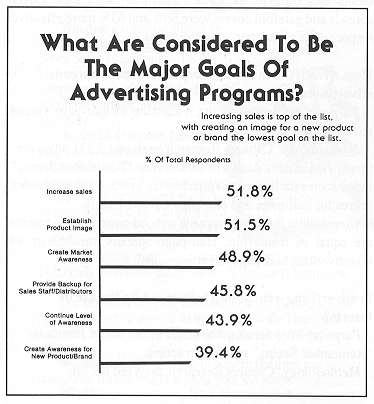Editor's note: The following story uses information taken from the Cahners Advertising Research Reports, a continuing series on the effectiveness of advertising in business publications.
What are considered to be the major goals of advertising programs?
Purpose: To determine what are considered to be the most important objectives in advertising.
Methodology: Cahners Research surveyed 2,000 recipients of Cahners Advertising Research Reports (CARR). Included in the survey was the question: "What are your major advertising goals?"
Conclusion: 742 replies were received, representing a response rate of 37.1%. Respondents considered increasing sales to be slightly more important than all other goals listed. Creating awareness for new product/brand was significantly lowest on the list.
 |
How is advertising readership influenced by ad size and color?
Purpose: To show the effect of size and color on "Remember Seeing" readership scores.
Methodology: This analysis used all half page or larger ads run in 16 Cahners publications from 1972 to 1986. The 65,752 ads were divided into categories by size and color. Median noted scores were then tallied, and comparisons made. Noted scores indicate the percentage of readers who remembered seeing the ad in the issue surveyed.
Cahners Advertising Readership Surveys are conducted by mail among a random sampling of 300-550 readers per issue. Noted scores for this analysis represent results from among 288,000 readers over a 15-year period.
 |
Conclusion: An advertiser can expect higher readership from larger full color advertisements.
Do cover advertisements receive higher " Remember Seeing" scores?
Purpose: To determine the advantages in cover position advertisements appearing in specialized business magazines.
Methodology: Cahners Research conducted a study which included 108 issues of Cahners publications. Overall readership scores were determined in Cahners Audits of Readership.
Cover positions include the inside front cover, inside back cover, and the back cover of the magazine. Cover spreads are two-page advertisements which include the inside front cover and the first page of the magazine. Gatefold covers are three-page advertisements in which the cover extends outward.
Conclusion: Single-page cover advertisements receive 40% higher "Remember Seeing" scores than all other advertisements appearing in specialized business magazines. Cover spreads and gatefold covers were 56% and 63% more effective respectively, than other advertisements.
How effective is the readership of half-page spread advertisements?
Purpose: To determine the readership of half-page spread advertisements.
Methodology: Cahners Research analyzed 7,331 advertisements via Cahners Audits of Readership. "Remember Seeing" index scores for half-page spreads were averaged against index scores for half-page and one-page advertisements.
Conclusion: Half-page spreads and one-page advertisements are equal in readership. Half-page spreads are 44% more effective than half-page advertisements.
Is advertising readership influenced by the use of inserts?
Purpose: To determine the effect of the use of inserts on "Remember Seeing" readership scores.
Methodology: Cahners Research analyzed 66,296 advertisements of fractional size or larger, run in 16 Cahners publications from 1972-1986. Cahners Advertising Readership Surveys are conducted by mail among a random sampling of 300-550 readers per issue. Noted scores for this analysis represent results from among 288,000 readers.
Conclusion: Insert advertisements receive 58% higher "Remember Seeing" readership scores than full-run advertisements.
Do coupons influence advertisement awareness?
Purpose: To determine if the use of coupons in advertisements influences advertisement awareness.
Methodology: Cahners Research reviewed 108 issues of specialized business magazines studied in Cahners Audits of Readership. "Remember Seeing" index scores for advertisements using coupons were averaged against all other advertisement scores. A total of 456 advertisements using coupons were studied.
Conclusion: "Remember Seeing" scores are 13% higher for advertisements using coupons than advertisements without coupons.
How does the mention of price influence advertisement awareness?
Purpose: To determine if advertisement awareness is influenced when a product/service price is mentioned in an advertisement.
Methodology: Cahners Research reviewed 108 issues of specialized business magazines studied in Cahners Audits of Readership. "Remember Seeing" index scores for advertisements with a product/service price were averaged against all other advertisement scores. A total of 361 advertisements with a product/service price were studied.
Conclusion: Advertisements which mention a price for the product or service receive 16 % higher "Remember Seeing" scores.
